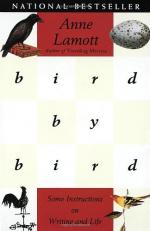
|
| Name: _________________________ | Period: ___________________ |
This test consists of 15 multiple choice questions and 5 short answer questions.
Multiple Choice Questions
1. What advice did Anne's father give her brother when he was overwhelmed at writing a report on birds?
(a) "Bird by bird, buddy. Just take it bird by bird."
(b) "Woody Woodpecker is a great bird to write about."
(c) "Take pictures of the birds in Bolinas."
(d) "Only write about California birds this time."
2. What was Anne writing about when she contacted an expert to help her with the set design?
(a) A kitchen.
(b) A vegetable medley.
(c) A Special Olympics race.
(d) A garden.
3. What was the image from a medieval monk, Brother Lawerence, that helped Anne come to terms with the residents in the nursing home?
(a) That we, like trees in the winter, have nothing to give, but are there to be loved unconditionally.
(b) Do not worry about tomorrow, today has enough worry for all.
(c) We are all dust in the wind.
(d) Treat others as you would want to be treated.
4. How does Anne define clutter?
(a) Makes her hold her breath.
(b) Easier to deal with if you put in specific piles.
(c) Something to be swept under the rug.
(d) Wonderfully fertile ground.
5. What did Anne's father tell his students to read?
(a) A few poems and hardback books.
(b) Shakespeare.
(c) Only Thurber.
(d) All the great books and plays they could get their hands on.
6. What is on Anne's desk that reminds her of short assignments?
(a) A short stubby pencil.
(b) A one-inch picture frame.
(c) A ruler.
(d) A pair of shorts.
7. Anne's editor loved the characters in her book, but what was the problem with the book?
(a) She had false starts all over the place.
(b) The garden was not believable.
(c) She had not brought them all together.
(d) The dialect was all wrong.
8. What is the question Anne's students always ask?
(a) What happens when a character changes?
(b) How do you know when you are done?
(c) How can you put an octopus to bed?
(d) How can I write like Dr. Suess?
9. When you start think there is one more thing you could do, what should you remind yourself?
(a) The octopus is snoring, time to move on.
(b) Dr. Suess refuses to eat the broccoli.
(c) Your characters have evolved, time to move on.
(d) Perfectionism is the voice of the oppressor.
10. In Anne's opinion, who writes bad first drafts?
(a) Reporters.
(b) She does.
(c) The birds.
(d) All good writers.
11. How does a writer end up with a good second draft or a terrific third draft?
(a) By hiring an excellent editor.
(b) By getting a good agent.
(c) By writing a bad first draft.
(d) By drinking lots of wine.
12. What does Anne tell her students the reason to write is?
(a) To create books.
(b) To find a good agent.
(c) To get noticed and make lots of money.
(d) To get published.
13. What advice did E. L. Doctorow have about writing?
(a) "Writing a novel is like making dinner. If you do prep work, the cooking comes easy."
(b) "Writing a novel is like driving a car at night. You can see only as far as your headlights, but you can make the whole trip that way."
(c) "Writing a novel is like taking a horse to water, but then he does not drink."
(d) "Writing makes me paranoid. I don't recommend it."
14. What does Anne say can reveal a character better than pages of description?
(a) Really off the wall dialect.
(b) Pages of dialog with descriptive wording.
(c) One line of dialog that rings true.
(d) The antagonist.
15. In Part 1, Section 6, Polaroids, who was the self-proclaimed "cool man?"
(a) A boy against a fence.
(b) Sam.
(c) A tall African American man.
(d) The referee of the basketball game.
Short Answer Questions
1. What is Anne's third suggestion about putting together good dialogue?
2. How does Anne describe the Polaroid?
3. How else does Anne say you might you know you are done?
4. What is at least half the battle Anne faces in her daily writing?
5. What can yield strange characters lurking in the shadows, according to Anne?
|
This section contains 807 words (approx. 3 pages at 300 words per page) |

|




